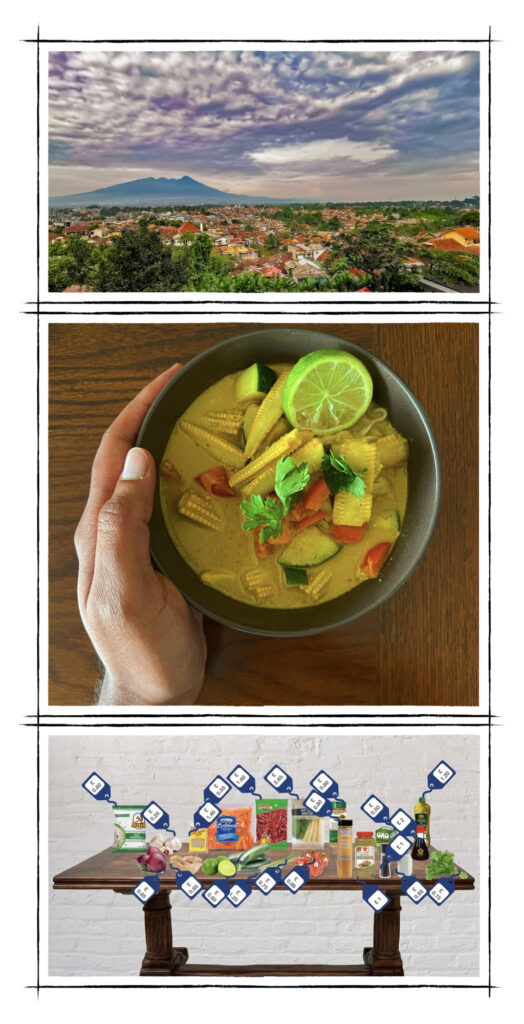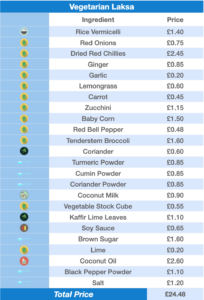
What’s In A Name
Country of Origin – Indonesia
Province – West Java
The Laksa – a spicy noodle soup – is one of South-East Asia’s most prominent and popular culinary contributions.
History proposes THREE theories about the origins of the Laksa.
THEORY 1: The Laksa dates back to the 15th century, during the time of the Ming Chinese naval expeditions led by Zheng He. The noodle soup was introduced to the world by the Peranakan/Straits Chinese – migrants from the mainland who partook in the expeditions and eventually settled in present-day Malaysia.
THEORY 2: The Laksa was birthed in Singapore after interactions between the Peranakans and the local Singaporean Malays.
THEORY 3: The Laksa was the product of a unification of different cultures and culinary ideas. Born from intermarriages between Chinese traders and local Indonesian women, who began to incorporate local spices and ingredients such as coconut milk into Chinese dishes, including noodle soups.
Well, there you have it! Which one do you think is more believable?

Our Connection
എവിടെ (Where) – Busaba – England, UK
എപ്പോൾ (When) – January, 2019
There’s nothing better in the world than a warm bowl of soup on a cold, snowy winter’s day. Whether it be a simple tomato, a cheeky little pumpkin, or in this case a mouth-watering Southeast Asian Laksa.
It was one of coldest days of the year. Despite a clear blue sky and a bright English sun, there was an unmistakeable chill in the air. My friend and I had just done a few rounds of the Emirates Stadium and a walk through Chelsea’s Stamford Bridge in an attempt to weather the cold and keep ourselves warm. It did the job for a while, but it still wasn’t enough.
It was nearing lunch time, and we decided to head back into the city centre, to the heart of London – Covent Garden – where we were in search for something warm and comforting. Enter Busaba and their recently launched special – the Chicken Laksa!
The massive noodle soup that arrived on the table would’ve been enough to feed my family of four, but given the long walk I had been on and the warmth I had been craving, it was the most welcome sight that day! Hale, hearty, and everything in between – the dish was the perfect antidote to the freezing weather. One that filled you up while warming the cockles enough to brave the weather on another walk back home.
Vegetarian Laksa
Description
"Welcome to our annual Laksa Taste Test! We've got 10 bowls in front of us - each filled to the brim with home-made Laksas. Our participants will simply have to taste and guess the region each Laksa's from. So, who's Laks-about to change today?!"
Ingredients
Instructions
-
Boil 100 ml of water in a kettle. Roughly chop1 the dried red chillies and place them in a small bowl
-
Pour the boiling water into the bowl until the dried red chillies are submerged. Cover the bowl either using aluminium foil or simply a plate. Leave it to rest for 10 minutes
-
While the dried red chillies are rehydrating, it's time to turn our attention to the vegetables
-
For the laksa paste: Roughly chop the red onion, ginger, garlic, and lemongrass. DON'T THROW THE LEMONGRASS STEM!!
For the laksa: Roughly chop the red bell pepper, baby corn, and zucchini into medium size chunks. Slice the carrot into 1/2 inch discs. Trim the fat end/stem of the tenderstem broccoli
-
It's time to make the paste!2 Add the rehydrated red chillies, the chopped red onion, ginger, garlic, and lemongrass to a blender. Season with turmeric powder, cumin powder, coriander powder, salt, and black pepper powder. Add a kaffir lime in the blender, followed by two tablespoons of coconut milk and a tablespoon of the red chilli infused water
-
Shut the blender with its lid and pulse3 until you get a slightly rough textured laksa paste. Preferably a few small chunks of the ingredients should still remain. If you prefer a smoother paste, you can add another tablespoon of water and pulse until smooth
-
In a large wok, add the coconut oil and bring it over a high heat. While the coconut oil melts, boil 500 ml of water in a kettle
-
Pour the boiling water into a long heat-proof glass. Drop the vegetable stock into the boiling water and stir until it completely dissolves
-
Once the coconut oil is warm, pour the laksa paste into the wok. Stir until the paste starts to darken in colour
-
Once the laksa paste has turned a nice amber shade, add the chopped and sliced vegetables into the wok.4 Sauté until the vegetables are well-coated in the paste and start to soften5
-
Once the vegetables are ready, pour the coconut milk into the wok and stir until it starts to change colour. Bring the heat down to a medium and let the broth continue to cook for 5 minutes
-
Pour the vegetable stock into the wok and give it another stir or two. Add a kaffir lime leaf and the stalk of the lemongrass (Step 4) into the broth. Leave it to simmer and cook for at least 20-30 minutes6
-
Halfway through the cooking process, pour the soy sauce and brown sugar to the broth. Stir until both dissolve in the laksa broth
-
It's now time to make the rice vermicelli. Immerse the dried vermicelli in a pot of warm simmering water. Soak them7 for roughly 20-30 minutes or until they start to soften but not break easily
-
Once cooked, pour the vermicelli into a large colander and leave it to cool for a few minutes
-
By now the laksa broth should be ready. Taste to see if the seasoning is perfect before taking it off the heat. Discard the kaffir lime leaf and the stalk of the lemongrass
-
To Serve (per serving): The Nadan Kozhi Curry can be served either with Malabar Parottas/Rice/Appams/String Hoppers (Idiyappams).
If served with Parotta/Appam, pour a generous ladleful of curry into a small bowl, and serve the parotta/appam on a side plate.
If served with Rice/String Hoppers (Idiyappams), place a heaped tablespoon of rice/a couple of string hoppers into the serving bowl, and pour a ladleful of the kozhi curry over the rice/string hoppers
Note
1. I use a scissor to cut the dried red chillies. You can also leave the dried red chillies as whole as they are anyway going to be blitzed in the end.
2. There are two ways to go about making the paste. The easiest option, which I chose, is to add all of the ingredients into a blender and pulse it until you get a slightly rough textured laksa paste. The longer but more authentic way is to use a Pestle & Mortar. Using the traditional technique requires you to pound the ingredients, one at at time, one after the other, in the mortar using the pestle until it becomes a thick rough laksa paste.
3. It is ideal if your blender has a Pulse option as this would result in a smoother paste than if you use the general grind/blend option. If you do not have the Pulse option, don't worry, you can use the general setting, although you may have to increase the quantity of water to get a smoother paste.
4. To speed up the cooking process, you can steam your vegetables in a steamer or in the microwave in advance. By steaming and softening them in advance, you only need to have them in the wok for a few minutes to marinate in the paste.
5. You don't want the vegetables to soften completely. There still needs be a little bit of a bite or crunch to them. The idea is to get them to a point where you can break them with a fork without too much of a struggle but they don't wilt away at the very first touch.
6. The longer you leave the broth to cook, the stronger the flavours will be as it will allow the laksa paste, kaffir lime, and lemongrass time to release its fragrances within the broth.
7. Depending upon the portion of rice vermicelli you're going to be using, soak the vermicelli in batches so as to not overcrowd the pot and ensure that each strand is soaked evenly.
8. The prices of the ingredients (table below) are only rough estimates and are subject to change!
9. As certain ingredients are common household items - salt, pepper, oil - you may not be required to purchase them, and so the cost of preparing this dish is lower.




